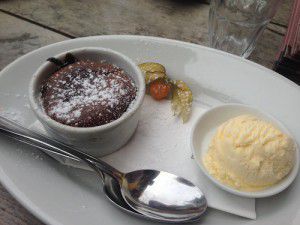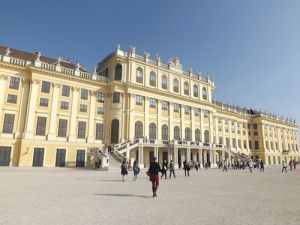Which language does Santa speak?
If, like me, you used to expectantly write a long list of improbable demands to Santa each year as a child, you’ll be curious to know what happened to those letters. Oddly enough, it never ever occurred to tiny Nat to question where the (probably unaddressed, definitely unstamped) letter went once it dropped into the post box: after all, if Santa was so magical then he’d surely have solved the small problem of how to access my very important letter.
But when I was recording Greenlandic recently for uTalk and doing some research on the country, I was intrigued to find that my letters actually may have reached Santa, and that he lived in Greenland. Until 2002, letters to Santa from all over the world would collect in a giant red post box in Nuuk and – here’s the exciting part – if they had a return address they’d be replied to by Santa himself (or an elf).
Sadly, Santa went bust in Greenland, and although letters may still end up there, they won’t be processed or answered. But, being super Santa, he obviously had a back-up plan and didn’t just run things from Greenland: Santa has operations going in Iceland, Sweden and Finland too. In fact, all of Scandinavia claims to be Santa’s home, raising the interesting question of which language Santa speaks.
Of course, we all know that Santa travels around the whole world on Christmas Eve and must therefore be fairly proficient in various world languages (he’s probably been dabbling in uTalk‘s Directions topic, available in 128 languages, to help him find his way), but just to prove it, his operation in Finland, still going strong, will reply to letters in up to 12 different languages from around the world. So Santa’s clearly at least a dodecalinguist!
Why not try to be a bit more like Santa this year and learn a new language? You could start off for free with the January uTalk Challengeand, if you really want to emulate Santa, go for the 12 month language challenge. Complete a language by the end of the month, and we’ll give you another free uTalk Essentials for a new language the following month.
Merry Christmas!
Nat
Rockin’ around the Christmas tree
Have you put up your Christmas tree yet?
Christmas trees are an iconic part of the festive season. It has become a tradition in many towns and cities to place a decorated tree in a central location for all to see, and many people also have a Christmas tree in their own homes.
The Christmas tree custom is believed to have started in Germany, with people bringing decorated Christmas trees into their homes. This became a trend across Europe with Queen Victoria decorating the first Christmas tree in Windsor Castle; with sweets, fruits and gingerbread.
In Trafalgar Square, London, receiving a Christmas tree from Norway has been a wonderful tradition since 1947. This is a gift to symbolise friendship and thanks, for Britain’s support during World War Two. The British Ambassador attends a ceremony in Norway during November, before the tree’s shipped to London for the festive season. This year @trafalgartree even has its own account on Twitter!
Another iconic Christmas tree is the one that stands at the Rockefeller Centre in New York. For those of you who love holiday films, this is the tree where the Christmas tree loving Kevin is reunited with his mum in Home Alone 2. 2015 marks the 83rd year of lighting this 10-ton Christmas tree with over 45,000 lights.
Last year Rio De Janeiro unveiled the world’s largest floating Christmas tree. It was 85 metres tall and had over 3.1 million lights! The lighting of the Christmas tree is the third largest annual event in Rio and each year carries a different theme; last year’s symbolised the importance of light in people’s lives. Unfortunately this year the tree’s metal structure was damaged and it’s had to be reduced to a mere 53 metres…
Here at EuroTalk we love to put up a Christmas tree in the office, it may not be 28 feet tall or have as many lights but it’s still fabulous 🙂
Do you have any Christmas tree traditions? Tell us about them on Facebook or Twitter.
EuroTalk Christmas Countdown starts here!
My countdown to this Christmas started on 26th December 2014; it’s my favourite time of year! I keep an app on my phone all year that counts down the number of sleeps until Christmas is back once again.
When it gets to the 1st of December, it’s traditional in the UK to use an advent calendar to count down the days up to and including Christmas Eve on the 24th. As a child, I was lucky enough to have a calendar with little pockets that my mum would place a chocolate and a little present in; these varied from pencils to hair bands.
We’ll be using my calendar at EuroTalk this year, to reveal a different Christmas word, in a different language, each day. You can countdown with us by following us on Twitter or liking us on Facebook – head on over now to find out what today’s word is, and see if you can pronounce it better than Ioana 😉
The idea of advent calendars originated from Germany, but soon spread across Europe and North America. Advent starts four Sundays before Christmas each year. People used to light a candle and allow it to burn down slightly more each day, representing how long there was until Christmas. Advent then moved onto boards with dates, and each day a different picture would be pinned onto the board. The first printed advent calendar dates back to the early 20th century, but during World War 2 production was stopped, in order to save cardboard and paper.
Advent calendars have become part of our annual Christmas celebrations. Today you can buy a standard calendar, which allows you to open little numbered doors and behind each one find either a picture or a chocolate. Alternatively you can buy ones with a gift behind each window; last year Harrods sold one shaped like a house that contained a different porcelain ornament for each day (we’re not sure how many they sold, though, as it cost £9,600…).
Do you have an advent calendar at home? What did you get for day 1?
Merry Christmas!
Alex
10 reasons to visit Vienna
Today’s ’10 reasons’ guest post comes from Charlotte, who’s currently living and working in Vienna, Austria. If you’d like to read more from Charlotte, you can follow her blog or find her on Twitter.
So here are 10 reasons to visit Vienna… Do you have any to add?
1. Have you seen how pretty it is?
One of the first things you’ll notice, if you go to Vienna, is the architecture. You name an architectural style and there are probably buildings in Vienna based on it, in some shape or form. And even if you’re not a massive fan of the City Hall, or the Burgtheater, then there are plenty of places to enjoy more modern buildings and designs, like the huge Main Public Library or even sitting on the Enzis (some colourful outdoor furniture) in the inner courtyard of the MuseumsQuartier. My favourite building in Vienna is the Hundertwasserhaus, a definite must see – and it’s not like it costs anything to look at it!
2. You can catch an opera or go to a museum.
There’s certainly plenty to choose from in the opera department. The Vienna State Opera (Staatsoper) offers more than 350 performances per season – that’s ballet, opera, and different concerts. If you don’t mind standing, it’s also not too expensive, though you do have to queue for a while beforehand. However, this is one of those things I would recommend if you aren’t in a hurry and you have a little bit of extra cash. Where would be a better place to see an opera but this historical city in a country famous for its musicians? Plus, there are a lot of museums in Vienna. There’s the Natural History Museum, the Art History Museum, the Leopold Museum, the Jewish Museum, the Museum of Technology… There are, in fact, over 100 museums in this city. Some of them are old palaces – like Belvedere or Liechtenstein City Palace – and some of them might seem odd – like The Third Man Museum or the Funeral Museum – but they’re all interesting and there’s something here to suit everyone.
3. You can eat at the Naschmarkt.
I’m not going to lie, the Naschmarkt is one of my favourite places in Vienna, for one reason only – it sells food. It’s around 1.5km long and people there sell spices, fresh fruit and vegetables, cheese, seafood, meats, bread… You name it and they probably sell it there. Plus, there are a bunch of small restaurants where you can sit and eat anything from Chinese dumplings to baklava to traditional Viennese food like Palatschinken. Yum!
4. You can chill out on the Donauinsel.
The Danube runs through Vienna, as it does through many other European cities, but here they’ve got an island that runs along the middle of it and you can reach on the subway. Especially popular in the summer, you can sit and have a picnic, or read, or do what others are doing and rollerblade or bike around it. Plus, every year they hold the Donauinselfest, an outdoor music festival and Europe’s biggest open-air event. Considering that its main purpose is to protect Vienna from flooding, it has developed into one of the main areas of entertainment in the city and is a lovely place to waste away a day or three.
5. You can – and should – eat Sachertorte.
Sachertorte is to Vienna what the Victoria Sponge is to the UK – maybe people don’t eat it every day, but they’re certainly aware of its existence and will take the time to explain to you that you should try it as soon as possible. What it actually is, is a dense, delicious, chocolate cake with dark chocolate icing, held together by apricot jam (yes – the apricot jam might seem a little strange at first, but when you consider that in the Austrian dialect they actually have their own separate word for apricot, then you’ll understand that you’re going to come across it often and maybe in surprising places). The ultimate place to eat it, apparently, is at the Hotel Sacher, but you can buy Sachertorte at probably every café in the city. Make sure you get a slice if you’re in Vienna on the 5th December – that’s National Sachertorte Day.
6. Vienna has the oldest zoo in the world!
You may have already heard of Schönbrunn Palace, which is an imperial summer palace and worth a visit, particularly on a sunny day. Well, on the same grounds is the Tiergarten Schönbrunn (Schönbrunn Zoo), which, having been founded in 1752, claims to be the oldest zoo in the world. It is one of a few zoos to house Giant Pandas (including three that were born in the zoo) and currently houses over 700 species. It is also one of few attractions in Vienna that is open 365 days a year (most things close on Sundays) – so you can go whenever you feel like it.
7. You can visit St. Stephen’s Cathedral.
It can get a bit dull visiting churches and cathedrals all the time, especially in a country like Austria, which is teeming with them, but if you only choose to visit one, then choose this one. This is Vienna’s landmark and it is the most important religious building in the city, and if you don’t feel like just going in for a look around, there is always the opportunity to attend a concert here instead. Plus, it sits on Stephansplatz, basically the city centre, so it’s not like you’ll miss it.
8. It’s an easy task to go wherever you want.
So maybe I shouldn’t highlight ways to leave the city in a post about why you should go there, but considering Vienna’s – and Austria’s – position in Europe, this was bound to come up. The fact is, it’s really easy to go somewhere else and, in most cases, it’s quite cheap too. It’s an hour to Bratislava; you just hop over the border into Slovakia and it’s less than 20€ for a return ticket. It’s three hours to Budapest, the other capital of the Austro-Hungarian empire (and worth a visit if you’re interested in exploring that theme) and four hours to Munich, or Innsbruck, or Prague. You can get cheap tickets to all of these places too, provided that you book in advance or that you get hold of some kind of discount card (not difficult to do). So, you know, if there isn’t quite enough to keep you entertained in Vienna, you can always make a quick trip somewhere else.
9. You can visit the Prater.
The Prater is a huge public park in Vienna, but probably the most famous part of it is the Wurstelprater amusement park, which takes up one corner. This is the home to the Wiener Riesenrad (the Ferris wheel), along with plenty of other rides, but also restaurants, bars, a Madam Tussauds and at least one night club. You could spend a day and a night here, if you wanted, as there’s plenty to do and as it costs nothing to get in (you pay per attraction), you can just wander around the park and explore.
10. If you come in December, you can visit a Christmas Market or five.
Much like the thing with the apricots, the Austrians have a different name for Christmas Markets (Christkindlmarkt) to their German counterparts, but the principle is somewhat similar. Late October to early November, you’ll see the stands being built and lights being strung – and then from the first weekend of November, the markets begin to open, selling drinks and food and decorations and gifts. I’m not sure exactly how many Christmas Markets there are, but essentially they’re everywhere, so you’ll just stumble across them as you wander the city. Like Germany, Glühwein (mulled wine) is a big thing here, but so is punch – and if you’re not so into the wine, you can buy Glühbier (mulled beer) in certain places. If you don’t drink at all, then there are plenty of places that offer non-alcoholic punch, in a variety of places. So, get a drink, buy yourself some food and soak up that festive atmosphere!
Charlotte
xuexisprachen.wordpress.com
@luna_moonsilver
(Photo credit: Charlotte Donnelly)
Do you have a favourite place that everyone should know about? Let us know!
Can uTalk a new language in one month?
Happy Thanksgiving to all our friends in the USA, and around the world! Before we know it, it’ll be Christmas, and then we’ll be into 2015. Time flies!
Here in the EuroTalk office, we enjoy a bit of healthy competition, and with the new year approaching, we’ve decided it’s a good time to take some of our own advice and try learning a new language, using our uTalk app. We’ll all be taking on different languages, and competing against each other to see who can learn the most in the 31 days of January. What could possibly go wrong?
The rules are simple:
1. The winner will be the first person to score maximum points on uTalk in the language of their choice, or the person with the highest score on 31st January.
2. The language chosen can’t be one we already speak.
3. Competitors must start from zero points on 1st January.
4. To join the challenge, we’ll need to have access to an iPhone or iPad with the free uTalk app installed.
Through regular check-ins, we’ll be keeping an eye on and reporting our progress both here and on our Facebook and Twitter, and we hope you’ll be there too, cheering us on.
If you fancy taking up the uTalk challenge for yourself, we’ll be very glad of the company, so drop us an email with the language you’ve chosen, and we’ll send you over a code to unlock the Essentials upgrade (worth £6.99) so you can get started completely free on January 1st.
And in the meantime why not let your friends know which language you’re planning to learn? (There are 100 to choose from, but don’t panic – you’ve got a month to think about it!)
So far, our competitors include:
Ioana, who’ll be learning French
Nat, taking on Icelandic
Steve, who fancies a go at Thai
Al, tackling Chinese (Mandarin)
Symeon, who’s torn between Greek and Turkish
… and Liz, who took a while to decide but eventually settled on German.
Wish us luck!








